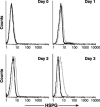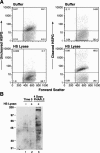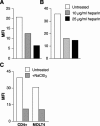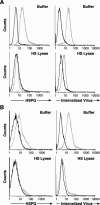Heparan sulfate proteoglycans mediate attachment and entry of human T-cell leukemia virus type 1 virions into CD4+ T cells
- PMID: 16188972
- PMCID: PMC1235841
- DOI: 10.1128/JVI.79.20.12692-12702.2005
Heparan sulfate proteoglycans mediate attachment and entry of human T-cell leukemia virus type 1 virions into CD4+ T cells
Abstract
Heparan sulfate proteoglycans (HSPGs) are used by a number of viruses to facilitate entry into host cells. For the retrovirus human T-cell leukemia virus type 1 (HTLV-1), it has recently been reported that HSPGs are critical for efficient binding of soluble HTLV-1 SU and the entry of HTLV pseudotyped viruses into non-T cells. However, the primary in vivo targets of HTLV-1, CD4(+) T cells, have been reported to express low or undetectable levels of HSPGs. For this study, we reexamined the expression of HSPGs in CD4(+) T cells and examined their role in HTLV-1 attachment and entry. We observed that while quiescent primary CD4(+) T cells do not express detectable levels of HSPGs, HSPGs are expressed on primary CD4(+) T cells following immune activation. Enzymatic modification of HSPGs on the surfaces of either established CD4(+) T-cell lines or primary CD4(+) T cells dramatically reduced the binding of both soluble HTLV-1 SU and HTLV-1 virions. HSPGs also affected the efficiency of HTLV-1 entry, since blocking the interaction with HSPGs markedly reduced both the internalization of HTLV-1 virions and the titer of HTLV-1 pseudotyped viral infection in CD4(+) T cells. Thus, HSPGs play a critical role in the binding and entry of HTLV-1 into CD4(+) T cells.
Figures









Similar articles
-
Human T-cell leukemia virus type 1 (HTLV-1) and HTLV-2 use different receptor complexes to enter T cells.J Virol. 2006 Sep;80(17):8291-302. doi: 10.1128/JVI.00389-06. J Virol. 2006. PMID: 16912281 Free PMC article.
-
The receptor complex associated with human T-cell lymphotropic virus type 3 (HTLV-3) Env-mediated binding and entry is distinct from, but overlaps with, the receptor complexes of HTLV-1 and HTLV-2.J Virol. 2009 May;83(10):5244-55. doi: 10.1128/JVI.02285-08. Epub 2009 Mar 11. J Virol. 2009. PMID: 19279090 Free PMC article.
-
Human T-cell leukemia virus type 1 envelope glycoprotein gp46 interacts with cell surface heparan sulfate proteoglycans.J Virol. 2003 Sep;77(18):9922-30. doi: 10.1128/jvi.77.18.9922-9930.2003. J Virol. 2003. PMID: 12941902 Free PMC article.
-
Current concepts regarding the HTLV-1 receptor complex.Retrovirology. 2010 Nov 29;7:99. doi: 10.1186/1742-4690-7-99. Retrovirology. 2010. PMID: 21114861 Free PMC article. Review.
-
Emerging Roles of Heparan Sulfate Proteoglycans in Viral Pathogenesis.Semin Thromb Hemost. 2021 Apr;47(3):283-294. doi: 10.1055/s-0041-1725068. Epub 2021 Apr 1. Semin Thromb Hemost. 2021. PMID: 33851373 Review.
Cited by
-
Molecular characterization of HTLV-1 gp46 glycoprotein from health carriers and HAM/TSP infected individuals.Virol J. 2013 Mar 6;10:75. doi: 10.1186/1743-422X-10-75. Virol J. 2013. PMID: 23510700 Free PMC article.
-
Antiviral strategies should focus on stimulating the biosynthesis of heparan sulfates, not their inhibition.Life Sci. 2021 Jul 15;277:119508. doi: 10.1016/j.lfs.2021.119508. Epub 2021 Apr 15. Life Sci. 2021. PMID: 33865880 Free PMC article. Review.
-
Heparan sulfate is an attachment factor for foamy virus entry.J Virol. 2012 Sep;86(18):10028-35. doi: 10.1128/JVI.00051-12. Epub 2012 Jul 11. J Virol. 2012. PMID: 22787203 Free PMC article.
-
Synthesis of heparan sulfate with cyclophilin B-binding properties is determined by cell type-specific expression of sulfotransferases.J Biol Chem. 2010 Jan 15;285(3):1701-15. doi: 10.1074/jbc.M109.018184. Epub 2009 Nov 23. J Biol Chem. 2010. PMID: 19940140 Free PMC article.
-
HIV-1 entry in SupT1-R5, CEM-ss, and primary CD4+ T cells occurs at the plasma membrane and does not require endocytosis.J Virol. 2014 Dec;88(24):13956-70. doi: 10.1128/JVI.01543-14. Epub 2014 Sep 24. J Virol. 2014. PMID: 25253335 Free PMC article.
References
-
- Altmeyer, R. 2004. Virus attachment and entry offer numerous targets for antiviral therapy. Curr. Pharm. Des. 10:3701-3712. - PubMed
-
- Argyris, E. G., E. Acheampong, G. Nunnari, M. Mukhtar, K. J. Williams, and R. J. Pomerantz. 2003. Human immunodeficiency virus type 1 enters primary human brain microvascular endothelial cells by a mechanism involving cell surface proteoglycans independent of lipid rafts. J. Virol. 77:12140-12151. - PMC - PubMed
-
- Barth, H., C. Schafer, M. I. Adah, F. Zhang, R. J. Linhardt, H. Toyoda, A. Kinoshita-Toyoda, T. Toida, T. H. Van Kuppevelt, E. Depla, F. Von Weizsacker, H. E. Blum, and T. F. Baumert. 2003. Cellular binding of hepatitis C virus envelope glycoprotein E2 requires cell surface heparan sulfate. J. Biol. Chem. 278:41003-41012. - PubMed
-
- Bernard, K. A., W. B. Klimstra, and R. E. Johnston. 2000. Mutations in the E2 glycoprotein of Venezuelan equine encephalitis virus confer heparan sulfate interaction, low morbidity, and rapid clearance from blood of mice. Virology 276:93-103. - PubMed
-
- Bernfield, M., M. Gotte, P. W. Park, O. Reizes, M. L. Fitzgerald, J. Lincecum, and M. Zako. 1999. Functions of cell surface heparan sulfate proteoglycans. Annu. Rev. Biochem. 68:729-777. - PubMed
Publication types
MeSH terms
Substances
Grants and funding
LinkOut - more resources
Full Text Sources
Other Literature Sources
Research Materials

